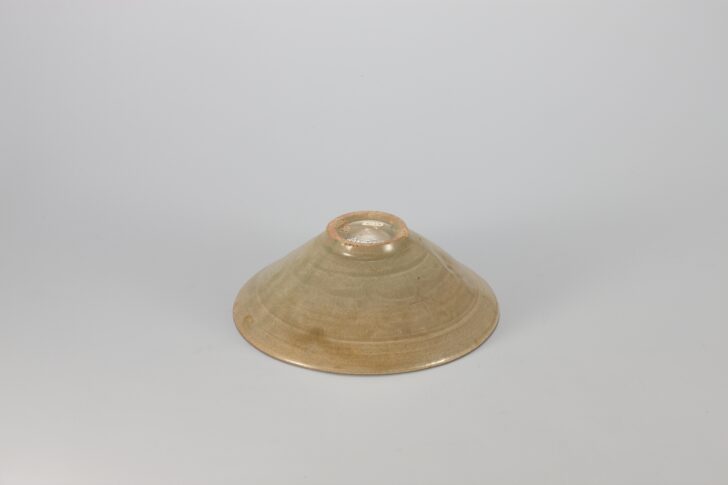Conical bowl with molded floral design
Korean

Description
Another technique that Korean potters adopted from Chinese ceramics, especially the Ding ware of northern China, was the use of molds. To make a bowl such as this one, the shape would first be thrown thickly on a wheel. When partially dry, it would be turned upside down over a hard ceramic mold and pounded with a mallet. The excess thickness of the bowl was then shaved away with a metal or sharp wooden tool.
The use of a mold allows for a standardization of design and requires less skill from the potter; still, great care was required to have the impression take and to gauge how much clay to remove to make the walls of the bowl of even thickness. The process was done by hand, and no two bowls are exactly alike.
Subject Matter:
Initially, Goryeo potters learned much of the technical expertise from the celadon traditions of Song-dynasty (960–1279) China, particularly of its southern coast. A Song envoy, Xu Jing (1091–1153), who visited the Goryeo capital, Gaeseong, in 1123, noted the resemblance of Goryeo ceramics to the celadons of China's Yue and Ru kilns. We see in early Goryeo examples a conscious emulation of certain stylistic features of Chinese wares—such as the shapes of bottles and bowls, and standard decorative motifs including lotuses, peonies, flying parrots, and scenes of waterfowl by the pond.
By the mid-twelfth century, Goryeo potters and patrons turned to articulating native tastes. This coincided with the consolidation of major celadon industries near the southwestern coast of the peninsula, in Jeolla Province—the Buan and Gangjin regions especially. The latter remains, today, the center of modern celadon production and of revivals of Goryeo traditions. The culmination of Goryeo celadon can be seen in inlaid (sanggam) celadon, a rarity in China. The delicate technique of sanggam involves etching the desired motifs on the dry clay body and filling in the carved space with black and/or white slip, after which the translucent glaze is applied and the vessel fired. The best of Goryeo inlaid celadon is breathtaking in its splendid presentation of clean form, vibrant design, and subtle yet alluring color combination of white, black, and green.
Physical Description:
This bowl has a narrow foot and a ared mouth. is type of bowl was produced in large quantities from the 11th century to the 12th century. Its inner wall has mold-impressed peony sprays. The entire body of the bowl is glazed, including the inside of the foot, but the glaze on its rim of the foot was wiped away, on which refractory spurs were adhered to for ring. Parts of the inner surface show ne crackles, while the inner bottom was stained with greenish-brown iron spots. One part of the rim was damaged and subsequently repaired. Glaze applied to the outer surface has partially owed downwards, resulting in an uneven surface, but the glaze and clay are quite well fused and sintered.
[Korean Collection, University of Michigan Museum of Art (2014) p.93]
The celadon bowl has straight-lined sides. The surface is evenly coated with a dark bluish green glaze. The celadon bowl rests on a rather tall foot, which was hollowed out from the bottom. The designs are present only on the inside of the vessel with the peony motif.
Usage Rights:
If you are interested in using an image for a publication, please visit https://umma.umich.edu/request-image/ for more information and to fill out the online Image Rights and Reproductions Request Form.